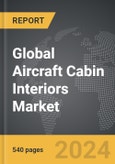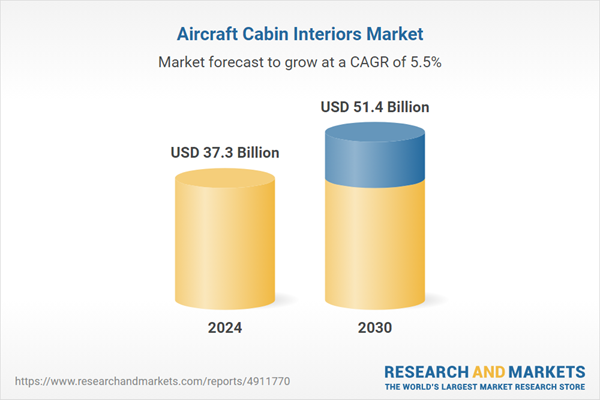Global Aircraft Cabin Interiors Market - Key Trends & Drivers Summarized
Aircraft cabin interiors are a critical aspect of the passenger experience, encompassing everything from seating and lighting to in-flight entertainment and lavatory design. The primary goal of cabin interior design is to enhance passenger comfort, safety, and convenience while optimizing space and reducing weight for fuel efficiency. Modern aircraft cabins are meticulously crafted with advanced materials and innovative technologies to create a pleasant and functional environment. Seats are ergonomically designed to provide maximum comfort, often featuring adjustable headrests, lumbar support, and various recline positions. Premium cabins, such as business and first class, offer luxurious amenities including lie-flat beds, private suites, and direct aisle access. Additionally, the integration of LED lighting systems, which can simulate different times of the day, helps in reducing jet lag by regulating passengers' circadian rhythms during long-haul flights.Technological advancements have revolutionized aircraft cabin interiors, leading to significant improvements in passenger experience and operational efficiency. In-flight entertainment systems have evolved from overhead screens to individual touchscreens offering a vast array of movies, TV shows, music, and games, all accessible on demand. Connectivity has become a key feature, with many airlines offering Wi-Fi and live TV, allowing passengers to stay connected and entertained throughout their journey. Moreover, advancements in material science have introduced lightweight, durable materials that contribute to overall weight reduction of the aircraft, enhancing fuel efficiency and reducing operational costs. Innovations such as noise-canceling technologies and improved cabin pressurization systems further enhance passenger comfort by providing a quieter and more stable environment. Additionally, smart cabin systems equipped with sensors and IoT technology allow for real-time monitoring and management of various cabin functions, improving maintenance efficiency and ensuring a seamless passenger experience.
The growth in the aircraft cabin interiors market is driven by several factors, including increasing air travel demand, rising passenger expectations, and advancements in aviation technology. As global air traffic continues to grow, driven by factors such as rising disposable incomes and expanding middle classes in emerging markets, airlines are investing heavily in upgrading their fleet interiors to attract and retain passengers. Passenger expectations for comfort and convenience are higher than ever, prompting airlines to differentiate themselves through superior cabin experiences. Technological advancements play a crucial role in this growth, as innovations in materials, connectivity, and entertainment systems enable the development of more sophisticated and appealing cabin environments. Furthermore, the trend towards lightweight materials and energy-efficient designs aligns with the aviation industry's goal of reducing its environmental footprint. Regulatory standards and safety requirements also drive continuous improvements and investments in cabin interiors. These factors collectively ensure robust growth and ongoing innovation in the aircraft cabin interiors market, reflecting the industry's commitment to enhancing the passenger experience while achieving operational efficiency.
Report Scope
The report analyzes the Aircraft Cabin Interiors market, presented in terms of market value (USD). The analysis covers the key segments and geographic regions outlined below.- Segments: Type (Seating, IFE, Lighting, Galley, Lavatory, Windows & Windshields, Stowage Bin, Panels); Material (Composites, Alloys, Other Materials); End-Use (OEM, Aftermarket, MRO).
- Geographic Regions/Countries: World; United States; Canada; Japan; China; Europe (France; Germany; Italy; United Kingdom; Spain; Russia; and Rest of Europe); Asia-Pacific (Australia; India; South Korea; and Rest of Asia-Pacific); Latin America (Argentina; Brazil; Mexico; and Rest of Latin America); Middle East (Iran; Israel; Saudi Arabia; United Arab Emirates; and Rest of Middle East); and Africa.
Key Insights:
- Market Growth: Understand the significant growth trajectory of the Seating segment, which is expected to reach US$11.4 Billion by 2030 with a CAGR of 6.1%. The IFE segment is also set to grow at 7.4% CAGR over the analysis period.
- Regional Analysis: Gain insights into the U.S. market, valued at $13.1 Billion in 2024, and China, forecasted to grow at an impressive 8.7% CAGR to reach $6.3 Billion by 2030. Discover growth trends in other key regions, including Japan, Canada, Germany, and the Asia-Pacific.
Why You Should Buy This Report:
- Detailed Market Analysis: Access a thorough analysis of the Global Aircraft Cabin Interiors Market, covering all major geographic regions and market segments.
- Competitive Insights: Get an overview of the competitive landscape, including the market presence of major players across different geographies.
- Future Trends and Drivers: Understand the key trends and drivers shaping the future of the Global Aircraft Cabin Interiors Market.
- Actionable Insights: Benefit from actionable insights that can help you identify new revenue opportunities and make strategic business decisions.
Key Questions Answered:
- How is the Global Aircraft Cabin Interiors Market expected to evolve by 2030?
- What are the main drivers and restraints affecting the market?
- Which market segments will grow the most over the forecast period?
- How will market shares for different regions and segments change by 2030?
- Who are the leading players in the market, and what are their prospects?
Report Features:
- Comprehensive Market Data: Independent analysis of annual sales and market forecasts in US$ Million from 2024 to 2030.
- In-Depth Regional Analysis: Detailed insights into key markets, including the U.S., China, Japan, Canada, Europe, Asia-Pacific, Latin America, Middle East, and Africa.
- Company Profiles: Coverage of players such as BAE Systems PLC, Collins Aerospace, Cobham PLC, Diehl Stiftung & Co. KG (Diehl Group), Bombardier, Inc. and more.
- Complimentary Updates: Receive free report updates for one year to keep you informed of the latest market developments.
Some of the 76 companies featured in this Aircraft Cabin Interiors market report include:
- BAE Systems PLC
- Collins Aerospace
- Cobham PLC
- Diehl Stiftung & Co. KG (Diehl Group)
- Bombardier, Inc.
- Buhler Motor GmbH
- Airbus Group SE
- Astronics Corporation
- ACRO Aircraft Seating Ltd.
- Aim Altitude
- Aviointeriors S.P.A
- Bucher Leichtbau AG
- Cyient Ltd.
- Burrana
- Committee for Aviation and Space Industry Development (CASID)
This edition integrates the latest global trade and economic shifts into comprehensive market analysis. Key updates include:
- Tariff and Trade Impact: Insights into global tariff negotiations across 180+ countries, with analysis of supply chain turbulence, sourcing disruptions, and geographic realignment. Special focus on 2025 as a pivotal year for trade tensions, including updated perspectives on the Trump-era tariffs.
- Adjusted Forecasts and Analytics: Revised global and regional market forecasts through 2030, incorporating tariff effects, economic uncertainty, and structural changes in globalization. Includes historical analysis from 2015 to 2023.
- Strategic Market Dynamics: Evaluation of revised market prospects, regional outlooks, and key economic indicators such as population and urbanization trends.
- Innovation & Technology Trends: Latest developments in product and process innovation, emerging technologies, and key industry drivers shaping the competitive landscape.
- Competitive Intelligence: Updated global market share estimates for 2025, competitive positioning of major players (Strong/Active/Niche/Trivial), and refined focus on leading global brands and core players.
- Expert Insight & Commentary: Strategic analysis from economists, trade experts, and domain specialists to contextualize market shifts and identify emerging opportunities.
Table of Contents
Companies Mentioned (Partial List)
A selection of companies mentioned in this report includes, but is not limited to:
- BAE Systems PLC
- Collins Aerospace
- Cobham PLC
- Diehl Stiftung & Co. KG (Diehl Group)
- Bombardier, Inc.
- Buhler Motor GmbH
- Airbus Group SE
- Astronics Corporation
- ACRO Aircraft Seating Ltd.
- Aim Altitude
- Aviointeriors S.P.A
- Bucher Leichtbau AG
- Cyient Ltd.
- Burrana
- Committee for Aviation and Space Industry Development (CASID)
Table Information
| Report Attribute | Details |
|---|---|
| No. of Pages | 540 |
| Published | December 2025 |
| Forecast Period | 2024 - 2030 |
| Estimated Market Value ( USD | $ 37.3 Billion |
| Forecasted Market Value ( USD | $ 51.4 Billion |
| Compound Annual Growth Rate | 5.5% |
| Regions Covered | Global |









